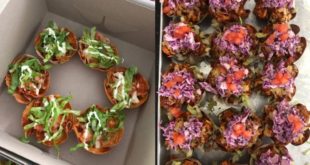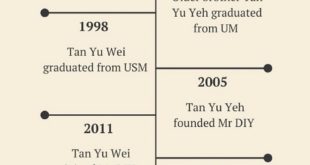Swee Choon Tim Sum Restaurant has become a name that is synonymous with dim sums, and it’s not surprising to always see snaking long queues at its Jalan Besar outlet.
The popular dim sum joint was founded by Ting Ah Swee and wife in 1962.
The couple later passed on the reins of the business to their eldest daughter Joyce Ting and eldest son Tony Ting, who joined as second-generation owners in 1976.
Tony currently helms Swee Choon as the Managing Director, and his nephew Ernest Ting — who formally joined the company in February 2020 –is now the third-generation owner of Swee Choo.
Over the past five decades, Swee Choon has expanded from a single unit shophouse to six connecting shophouse units that can occupy 420 diners.
Taking Over His Grandfather’s Business

When asked why he took over his grandfather’s business, the 29-year-old simply said that he always had an interest in F&B.
Moreover, the restaurant needed manpower so when his uncle Tony asked if he could join the company, he readily agreed because he felt confident that he could “value-add to the business”.
Ernest has a bachelor’s degree in accounting and finance from Exeter University, and a postgraduate master’s degree in finance from the London School of Economics.
Despite the finance background, he had always helped out at Swee Choon during school holidays or during his free time so the business is not at all unfamiliar to him.
Although he is lacking in terms of business experience, Ernest expressed his gratitude towards his uncle who has helped guide him along the way.
“He is also open to new, transformative ways to improve the business,” he added.
Innovating To Adapt With The Times
With F&B being one of the worst-hit sectors by the pandemic, it’s not surprising that sales has dipped for Swee Choon.
During the circuit breaker period, their profits declined by about 40 per cent.
In Phase 2 of the reopening, Swee Choon had to halve its dine-in capacity and shorten operating hours.
“Our dine-in revenue has decreased by 30 per cent, and our year-on-year sales has dropped by around 10 per cent,” Ernest told Vulcan Post.
However, the upside is that they saw a spike in delivery sales.
“Our food delivery and takeaway revenue increased from 15 per cent (pre-COVID-19) to 70 per cent of our total sales. We believe this momentum will continue even after COVID-19 is over,” he added.

To cut down on losses from dine-in sales, the restaurant focused their efforts on online sales, digital marketing and tapped onto additional food delivery platforms to reach more customers.
These efforts have helped to increase Swee Choon’s sales from food delivery significantly, from less than one per cent to around 60 per cent of its existing average monthly revenue during the circuit breaker.
The COVID-19 pandemic has definitely stepped up their digitalisation efforts. Changes have to be implemented for the business to survive, stressed Ernest.
When COVID-19 hit, it was a bit of a challenge as we had to make sure that our operations could process delivery orders smoothly when dine-in wasn’t allowed. We managed to reorganise and train the staff to handle new roles, and improved our online ordering mechanics as well.
During the reopening of Phase 2 for F&B businesses, we faced a challenge to reorganise our limited seating capacity. We managed to resolve the seating and long queue issue by introducing a virtual queue system where customers can reserve a table anytime and anywhere.
– Ernest Ting, third-generation owner of Swee Choon
Due to manpower issues, Swee has also leveraged QR codes to improve their ordering system so that customers could place orders conveniently without downloading an app.
“Almost 90 per cent of our diners now use the QR code to order their food,” said Ernest.
Additionally, Swee Choon also revamped its dim sum restaurant to include ordering kiosks. They’re also looking to deploy an automated system in the future to send food across the shophouse units without the need for runners anymore.
Minister Chan Chun Sing, who visited Swee Choon restaurant three weeks ago, praised the 58-year-old eatery for embracing digitalisation and pivoting online to remain competitive during this challenging time.
“As a result of their ability to adapt quickly, Swee Choon’s revenue is now back to pre-COVID-19 days thanks to revenue generated from their food delivery business,” said Mr Chan in a Facebook post.
Swee Choon Joins The Cloud Kitchen Bandwagon
Swee Choon was due to open a second outlet in April at Nex mall but plans for that has since been postponed due to the pandemic.
The central kitchen will develop a new line of frozen dim sums to be sold directly to online consumers instead.

It has also set up a cloud kitchen at Tampines Food Co last month, which offers both dine-in and delivery options for customers.
For those unacquainted, a cloud kitchen is an ecosystem of shared kitchens, storage facilities and delivery infrastructures.
This setup allows business owners to reduce their overhead costs and expand their reach to more diners via on-demand delivery services. Customers too can enjoy lower delivery fees as well as shorter waiting time.

Residents in the area can also order from Swee Choon through food delivery apps like GrabFood, foodpanda and Deliveroo. Previously, those living outside of Jalan Besar area could only order through Oddle.
Aside from a la carte classics and bento sets/value meals, Swee Choon also offers two dishes that are exclusive to its Tampines outlet: Hong Kong Fried Dim Sum Platter and Hong Kong Steamed Dim Sum Platter.
The best part about cloud kitchen is that it requires a low capital commitment. The cloud kitchen idea came about as islandwide delivery was very costly, and we wanted to find a way to optimise delivery cost.
From our delivery data history, we were able to map out the high traffic zones and identified Tampines as one of the hot spot zones. Hence we decided to go into the cloud kitchen in the East to better serve our customers there.
– Ernest Ting, third-generation owner of Swee Choon
Commenting on the food delivery landscape, Ernest said that “cloud kitchens are poised to be the next big thing” as he observed many investors funnelling millions of dollars into these ‘hub’ kitchens.
True enough, cloud kitchens seem to be on the rise in Singapore.
This year, Jollibee opened its first cloud kitchen in Singapore and TiffinLabs, founded by Singaporean billionaire R. K. Kishin, is expanding to 1,000 cloud kitchens worldwide.
What’s Next: A 2nd Outlet, Maybe A Kiosk Concept

When asked about their secret to success, Ernest attributed it to their unique late-night opening hours. Pre-pandemic, Swee Choon used to open from 11.30am to 6am, six days a week.
Although COVID-19 has shortened their operating hours, they are still open till 1am now (for its Jalan Besar outlet).
Swee Choon has become a popular late-night supper spot, especially with the younger crowd. We have also expanded our menu over the years, first to include Shanghai-style dim sum in 2007, and then Zi Char dishes in 2012.
This caters to an even wider range of gourmands and their word-of-mouth recommendation helped Swee Choon to become the successful F&B chain it is today.
– Ernest Ting, third-generation owner of Swee Choon
He went on to impart a piece of business advice to fellow entrepreneurs: “know your target audience, have a strong value proposition and a solid product.”
I think to last in this competitive industry, we need to plan our business model to adapt to the changing times and culture, hence our investment into a central kitchen and cloud kitchen.
Of course, the quality and standard of the food should also be maintained, which is why we still insist on having our dim sum made by hand instead of by machines.
– Ernest Ting, third-generation owner of Swee Choon
His grandfather had always emphasised on using fresh ingredients and handmade dim sum to serve the best quality Swee Choon dim sum to customers.
He had also emphasised the importance of treating the staff well with good benefits, as they are the “primary asset” of a company.
Sharing future business plans, Ernest said that Swee Choon is exploring different models and concepts.
“Instead of a full-fledged restaurant which is manpower-intensive, we are planning new developments which is leaner and more scalable in nature such as kiosk concepts and small express eateries.”
Swee Choon will also be opening a new outlet in Serangoon in March 2021, and are currently exploring franchising opportunities.
Ernest also shares that he intends to open two more cloud kitchens in Singapore, with plans to open one in the north area and another in the west.
Featured Image Credit: Swee Choon



